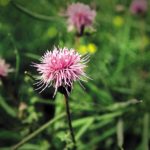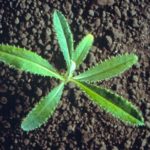Reading Time: < 1 minute An updated Weed Seedling Guide is now on sale. “The second edition of this convenient, pocket-size booklet helps producers and others correctly identify weed seedlings,” said provincial weed specialist Nicole Kimmel. “Proper identification allows you to take the appropriate measures to deal with weeds.” The $10 coil-bound publication features information on 62 broad-leaved weeds and […] Read more

Updated weed guide available

This toxic hitchhiker is a threat to livestock
Noxious Weeds: Hound's tongue
Reading Time: < 1 minute Hound’s tongue is a weak competitor and doesn’t do well in healthy rangeland — but it compensates for that by being an excellent hitchhiker. This noxious weed produces up to 4,000 seeds per plant, and each one is barbed and easily attaches itself to clothing or fur. It also produces toxic alkaloids that cause irreversible […] Read more

New Swedish machine slices problem weeds down to size
Organic grain growers have been snapping up CombCut machines ‘like crazy’
Reading Time: 3 minutes A new piece of machinery is helping crop growers control broadleaf weeds on their farms — especially on organic operations. “Organic growers are buying these CombCut machines like crazy,” said Steve Shirtliffe, a professor of plant sciences at the University of Saskatchewan. “There’s a real buzz in the organic farming community. I’ve never seen equipment […] Read more

Beware of this ornamental escapee
Reading Time: < 1 minute It has a beautiful yellow showy flower, but do not let that fool you — Bighead Knapweed is highly invasive. This invader is a long-lived perennial native in eastern Europe. It produces an abundance of seeds, which have bristles that can easily attach to animal fur. It can be found in flower beds throughout Alberta. […] Read more

Did your spraying do the trick?
If weeds survived, you need to figure out what went wrong so you can avoid a repeat
Reading Time: < 1 minute Field scouting after herbicide application can lead to more successful crop production. “In the majority of cases, producers will find that the chemicals have done their job” said provincial crop specialist Mark Cutt. “However, in certain situations, field scouting may show the weeds weren’t properly controlled.” If so, figure out what went wrong. “A difference […] Read more

This tenacious invader is hard to defeat
Reading Time: < 1 minute White cockle has strikingly lovely white flowers and the fuzzy, almost furry opposite leaves give it a distinctive appearance. It is a member of the Pink family — it looks like pinking shears gave the five petals their deep notches. The Pink family includes chickweed and night flowering catchfly — catchfly is often mistaken for […] Read more

There are many reasons to hate this nasty weed
Reading Time: < 1 minute Medusahead rye is a cool-season annual grass that is rapidly invading many northwestern U.S. states. It also has the potential to invade the Canadian Prairies because it can survive very cold winters and thrive in clay soils. Similar in appearance to foxtail barley (although the seed head does not break apart at maturity), medusahead contains […] Read more

Keep watch for this wetland invader
Reading Time: < 1 minute Flowering rush has been spotted in a few locations in Alberta, including an infestation on Lake Isle, located in Lac St. Anne and Parkland counties. Flowering rush is a perennial of freshwater wetlands that is native to Africa, Asia and Europe and was introduced to North America as an ornamental plant species. It is a […] Read more

Rain holds up spraying as weeds thrive in Manitoba
CNS Canada –– A steady dose of rain to start the week has put a crimp on herbicide applications across Manitoba. While weeds weren’t noticeable a few weeks ago due to the relative dryness, they’re definitely becoming more noticeable, according to crop watchers. “We know that with the rain and warmer temperatures, both the crops […] Read more

Weed an enemy of disturbed soils
Noxious Weeds: Scentless chamomile prolific and problematic
Reading Time: < 1 minute Scentless chamomile can be found across the province. Starland County, Parkland County, MD of Lesser Slave River, and Saddle Hills County are just a few of the municipalities with confirmed populations of this plant. Scentless chamomile is a prolific seed producer, with large, healthy plants able to produce up to one million seeds each. Plants […] Read more

